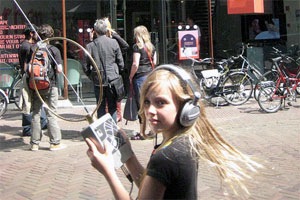Last week we announced the sixth edition of This happened – Utrecht. The program was up on our Dutch site already, here’s the program in English (soon available on our international .org site, too). As always I am very excited about the line-up. Can’t wait to hear what stories these people have to share about their work. Doors open on Monday 10 May at 7:30PM. The registration starts on Monday 26 April at 12:00PM. See you there!

Keez Duyves is one of the cofounders of PIPS:lab, based in Amsterdam, NL. Archie and the Bees, their newest theatrical concept, links the primary colors red, green and blue to the primary elements of rhythm: kick, snare and hi-hat. In this hybrid of multimedia performance and installation, PIPS:lab demonstrate their revolutionary Radarfunk machine — allowing them to generate sound from color. A light painting or the colors in the audience serve as musical basis over which PIPS:lab improvise and amaze with their other self-developed instruments: the Bashblender, the Grinder and the LCDC video guitar.

Matt Cottam is the founder of Tellart. Wooden Logic represents the first phase in a hands-on sketching process aimed at exploring how natural materials and craft traditions can be brought to the center of interactive digital design to give modern products greater longevity and meaning. It is only in the past decade or so that the community and tools have evolved to the point that designers can sketch with hardware and software; which before that was the sole domain of engineers and computer scientists. This project seeks to combine seemingly dissonant elements, natural, material and virtual, and explore how they can be crafted to feel as if they were born together as parts of a unified object anatomy that is both singular and precious.

Sanneke Prins and Berend Weij are co-founders of Mijn naam is Haas, a company that produces a range of educational products aimed at primary education. These products are all situated in the world of the main character Haas. The range consists of illustrated children’s books, CD-ROMs and an online learning environment, in which the vocabulary of toddlers is increased through game principles. Children create the world of haas by drawing. All drawing actions directly influence the unfolding story, so each play session is unique which makes the game continuously engaging. In this creative process language elements are presented in a playful manner. The first version of the game was created by the founders during their attendance of the EMMA program at the HKU.

Sebastiaan de With is an interface and icon designer working under the name Cocoia. He designs, teaches and runs a popular blog on interfaces and icons. Sebastiaan is easily recognized in Drachten wearing his Exploded Settings Icon or Bricky shirt and toting an iPad. Classics is one of the first popular e‑readers on the iPhone, offering public domain books in a well-designed experience. The project was initiated by the Phill Ryu, (in)famous for MacHeist and his support of the Delicious Generation. Clearly the Classics app is a feat of design driven development, complete with an inspired wooden bookshelf, curling page turns (both now also available on the iPad), marvelous icons and a collection of lovingly designed book covers.
We wouldn’t be able to pull off this edition with the support of the Utrecht School of the Arts and Microsoft Design Toolbox. Thank you!
















